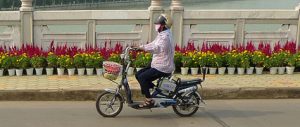chinadialogue, together with environmental NGO Friends of Nature, has published a report into the growth of public bike-hire schemes in China. The report, “Urban bicycle hire in China” is only available in Chinese, so for the benefit of our English-language readers, we provide a brief account of the findings below.
Beijing’s public bicycle scheme (PBS) started in 2008, as part of the city’s efforts to host a “Green Olympics”. It was never popular, and it was only this year, after repeated calls, that the government increased its support.
Two other cities, Wuhan in central China and Hangzhou in the east, started their own bike hire schemes around the same time as Beijing. Researchers say that differences in outcomes across the three cities demonstrate just how important government support is to making a public bicycle programme work.
Beijing’s bicycle hire companies go bust
Beijing has had a basic bicycle hire industry since the 1990s. But it only really got going in 2007, in the run-up to the city’s Olympics. During the Games, bikes could be rented for 5 yuan an hour, or 20 yuan a day. To residents used to paying 0.4 yuan bus fares, this seemed expensive, and there was also a shortage of rental locations. Bike hire, despite the fanfare, was not popular.
The bike-hire companies were in a tough position: barely breaking even, and with no money for expansion. Most just carried on, hoping either to be taken over by the public transport system or awarded subsidies.
The Beijing Bicycle Rental Company was one of those firms.
Bai Xiuying, company manager at the time, described bike-hire schemes as a public service, with little profit: the company could not make enough to expand. To a degree, bicycle hire schemes are a type of municipal infrastructure but, as Bai explained: “It’s virtually impossible for a private company to deal with the industrial and commercial authorities, the tax bureau, the utilities and the municipal environment and administration authorities.”
See also: A two-wheeled future for China
Her company had 200 outlets and over 8,000 bikes at the time of the Olympics, during which over 100,000 journeys were made. But by 2010, only 12 outlets and a few hundred bikes remained. In the end, the company failed.
Another business, Fangzhou, met a similar fate. In May 2009, Fangzhou was Beijing’s biggest bicycle hire firm, boasting plans for a rental point every 200 metres within Beijing’s 5th ring road. Within a year, the company had closed down, having netted losses of over 10 million yuan (US$1.6 million).
Professor Pan Haixiao of Tongji University in Shanghai said: “The most important factor in setting up public bicycle schemes is whether or not the government includes it in overall urban planning.” Pan studies bicycle hire schemes in Chinese cities, and believes that in Beijing there was a lack of clear government support.
In 2005, Beijing set itself the goal of becoming a “liveable city” with a “coordinated transportation system” covering walking, cycling, buses and the subway. But it wasn’t until March 2010, with the launch of the “Green Beijing Action Plan 2010-2012”, that the development of bike-hire schemes was actually mentioned. By this point, it was already too late for many bike hire companies.
The report “Walk and Ride in a Liveable Beijing”, published by environmental NGO Friends of Nature in 2010, described Beijing’s bicycle hire services as business-led and lacking government planning and policy support. The individual companies had limited finances and personnel, and expansion was slow.
Wuhan’s bike scheme: large-scale, low-profit
Companies setting up a bike hire scheme need to deal with red tape at a number of different government authorities. But political backing can speed things up, particularly when coordination is needed across different government departments.
Two different approaches were used in Wuhan and Hangzhou.
In Wuhan, the government did not get directly involved, but awarded advertising, operations and other rights to a company. The company then used its income to set up and run the scheme. So, in exchange for government-controlled resources, the company provides investment and services. This stands in contrast to other arrangements, where the government either funds and manages the scheme itself, or pays a company to provide the service.
Wuhan is proud of its “government-led, business-run” approach, styling it the “Wuhan Model”. Currently, public bike hire services in six of the city’s seven central districts are run by local company Xinfeida, with the remaining district of Qingshan covered by Shanghai firm IbikeMedia. In the four years to April 2012, Xinfeida’s Wuhan operations had expanded from 12 rental locations and 1,000 bikes to 1,318 locations and almost 90,000 bikes.
See also: Full-circle for bikes in Beijing?
This does not mean that Wuhan’s government did not put in any money or effort. Xinfeida relied on government backing for much of the 200 million yuan invested in setting up its network. For example, the government is paying the interest on a 50-million yuan unsecured loan from Pudong Development Bank used to develop the scheme. And, since 2010, the government has been providing subsidies of 100,000 yuan for each new rental location and 100 yuan for each new bike.
Despite all this, Xinfeida has only recently managed to break even. Turning a profit will have to wait.
Wuhan’s government played a major role in backing the bike hire scheme, but it may not have been enough.
Pan Haixiao believes Wuhan still places too much of the burden on private firms, and Sun Jisheng, manager at Hangzhou’s Yong’an Public Bicycle System Ltd, agrees. He says: “It takes six months to a year to set up a PBS, and ordinary companies struggle with the complex arrangements and large up-front investments needed. The government has to come up with real money and policy support if it is to work.”
Hangzhou integrates bikes into planning
That is why, in Hangzhou, the government did it all. State-owned company Hangzhou Public Bicycle Transport Services Development was founded as a subsidiary of the city’s public transport corporation to set up and run the public bike hire scheme. Government support was provided in the form of funding, land and improved rights of way for bicycles.
Hangzhou has China’s densest bike hire network, with hire locations every 100 metres on average. Each bike is used an average of five times a day, and the public bike hire scheme is now a major form of transportation for Hangzhou residents.
“This is because, from the start, Hangzhou saw the bikes as part of the public transportation system, and planned for it as a public service,” Pan has written. He says that as a tourist city Hangzhou wants to make things easier for visitors – and so it did its best to make the scheme work.
The three cities of Beijing, Wuhan and Hangzhou show differing degrees of government support for PBS. There is another model, somewhere between those adopted by Wuhan and Hangzhou, operating in Suzhou, Changshu, Nantong, Xuzhou and Zhangjiagang. In these cities, the government pays a company to provide bike hire services.
Sun Jisheng believes that PBS should be seen as an element of public transportation, to be subsidised like urban buses or subways, while purchasing services from private companies can avoid the inefficiencies and waste of public resources associated with state-owned firms.
Wang Zhigao, transportation officer at the Energy Foundation, says: “Public bike hire is a public service, and the government should take the bulk of responsibility for it.” Wang also says that the public should be involved in choosing rental locations and reporting damage, to make it a true public service and also to avoid the inefficiencies that potentially arise when the government is in complete charge.
Chen Mei of Zhejiang University’s College of Economics says the government should act as a lever: it should choose the appropriate model, but always look for the most effective way to apply its efforts.




